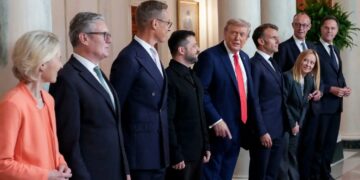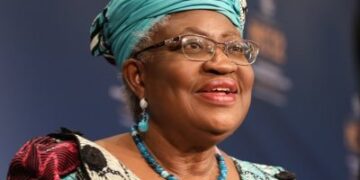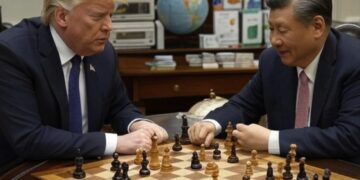As Chinese manufacturers take to social media to expose the true costs of American and European luxury brands, stakeholders—investors, CEOs, and policymakers—are facing a dual challenge: navigating economic volatility and rethinking the value of prestige. Drawing on insights from the International Monetary Fund (IMF), World Trade Organization (WTO), World Bank, and real-time market data, this article unpacks the stakes, the exposés, and strategies for thriving in this turbulent landscape.
Markets in Flux: A Snapshot of Sentiment
Global financial markets are reeling as the trade war intensifies. In early April 2025, the U.S. Nasdaq plummeted nearly 6% in a single session, driven by fears of supply chain disruptions in tech and manufacturing—sectors heavily reliant on Chinese components. Across the Atlantic, the UK’s FTSE 100 shed 313 points (3.7%), one of its steepest drops in over two years. Asian markets followed suit, with Chinese and Japanese indices reflecting anxiety over shrinking trade prospects.
Currencies are equally rattled. The U.S. dollar surged 1.65% after new tariff announcements, fueled by expectations of inflation and tighter monetary policy. Meanwhile, the euro slid 1.89% to a 10-month low, and the Chinese yuan weakened under export pressures. Commodities face uncertainty: while U.S. oil and gas may benefit from domestic policy shifts, global agricultural and energy markets brace for trade barriers that could spike costs.
For stakeholders, volatility is the new normal. Sectors like pharmaceuticals, automotive, and clean energy are particularly exposed. Indian drugmakers saw shares tumble over 6% amid tariff confusion, while multinationals fear rising costs and shrinking markets. Yet, opportunities may emerge for firms that pivot to alternative suppliers or localize production.
The Big Picture: Warnings from GlobalRosa Institutions
The IMF, WTO, and World Bank are sounding alarms, urging restraint to preserve global economic stability. Here’s what they’re saying:
IMF: A Fragile Recovery at Risk
Kristalina Georgieva, IMF Managing Director, warned on April 7, 2025, that U.S. tariffs threaten a “significant risk” to global growth, already limping at 3.2% for 2025. The IMF projects a potential 0.3% GDP hit from trade disruptions, with worst-case scenarios slashing output by up to 7% if tensions spiral. For stakeholders, this underscores the need for diversified markets to cushion shocks. The U.S. is forecast to grow 1.8% in 2025, while China’s growth dips to 4.8% in 2024, signaling uneven impacts.
WTO: Trade Under Siege
The WTO estimates that a full-blown U.S.-China tariff war could slash bilateral trade by 80% and global GDP by nearly 7%. Despite a 2.7% rise in global trade volumes in 2024, new barriers—like proposed 125% U.S. tariffs on Chinese goods—could erase gains. The WTO calls for modernized trade rules, especially in digital and green sectors, to prevent fragmentation. Stakeholders should note that services trade, worth $3.8 trillion in 2022, remains a growth frontier but isn’t immune to disruption.
World Bank: Protecting the Vulnerable
While the World Bank hasn’t directly addressed April’s tariff hikes, its 2024 advocacy with the IMF and WTO emphasizes open trade to lift developing nations. It warns that protectionism could deepen food insecurity and debt distress in low-income countries, where import costs for essentials like fuel and fertilizer are already climbing. Emerging markets, projected to grow 4.2% in 2025, face heightened risks, urging stakeholders to prioritize inclusive supply chains.
Luxury’s Illusion Unraveled: Chinese Manufacturers Speak Out
Amid the trade war, Chinese manufacturers have unleashed a torrent of revelations on platforms like TikTok, exposing the production costs of American and European luxury brands. These exposés, fueled by U.S. tariffs as high as 145% and China’s retaliatory 125% duties, challenge the mystique of labels like Gucci, Prada, Hermès, and Ralph Lauren. Manufacturers claim that up to 80% of these luxury goods are made in Chinese factories at a fraction of their retail prices, then shipped to Europe or the U.S. for final labeling as “Made in Italy” or “Made in USA.”
One viral video showcased a Hermès Birkin bag, retailing for $38,000, allegedly produced for just $1,000 in China—same materials, same quality. Another exposed Lululemon’s $100 yoga pants, claiming near-identical versions cost $5–6 from the same Yiwu factories. Brands like Chanel, Dior, and Coach face similar scrutiny, with creators alleging that $500 handbags cost $30 to make, and Chanel cosmetics, priced at a premium, are manufactured for $5. Chinese factory workers have shared footage of production lines, revealing contract orders for Michael Kors, Nike, and Calvin Klein, long marketed as American or European craftsmanship.
These revelations are more than a trade war tactic—they’re a direct challenge to consumer trust. Manufacturers are bypassing brands, offering “logo-free” versions or direct sales via platforms like Alibaba and WeChat, leveraging the U.S. “de minimis” rule to ship packages under $800 duty-free. This grey market surge is eroding luxury’s perceived value, with Chinese consumers increasingly favoring local brands, whose share of global luxury sales has dropped from 50% a decade ago to 12% today. For stakeholders, this signals a seismic shift: the luxury sector’s soft power, once a hallmark of Western dominance, is under threat as transparency reshapes perceptions of quality and status.
Data Driving Decisions
The numbers paint a stark picture:
Trade Flows: China’s exports jumped 12.7% in October 2024, swelling its trade surplus to $95.27 billion as firms rushed to beat tariffs. Yet, the WTO warns that U.S.-China trade could shrink by 80% under sustained tariffs, disrupting global supply chains.
Economic Growth: The IMF pegs global GDP growth at 3.2% for 2025, with downside risks mounting. The U.S. expects 1.8% growth, while China’s slowdown to 4.8% in 2024 may worsen. Emerging markets, at 4.2% growth, face pressure from trade shocks.
Market Moves: Beyond the Nasdaq’s 6% drop, European and Asian indices faltered, with declines of up to 6%. Currency shifts include a 1.65% dollar surge and a 1.89% euro slide. Treasury yields are climbing, signaling capital flow concerns for emerging markets.
Tariff Impact: U.S. tariffs, potentially hitting 125% on Chinese goods, met China’s 34% retaliation on U.S. imports, effective April 10, 2025. The IMF estimates a 0.3%–7% global GDP hit, depending on escalation.
Luxury Markups: A $38,000 Hermès Birkin costs $1,000 to produce; Lululemon’s $100 leggings cost $5–6; a $500 Coach bag costs $30; Chanel cosmetics, sold at luxury prices, cost $5 to make, according to Chinese manufacturers.
Strategies for Stakeholders
Navigating this trade war demands agility. First, diversify supply chains—explore sourcing from Southeast Asia, India, or Latin America to reduce reliance on U.S. or Chinese markets. Second, invest in technology to boost efficiency as cost pressures mount. Third, monitor policy shifts: U.S. deregulation may open energy opportunities, while China’s export controls could tighten critical materials access. Fourth, reassess luxury investments—brands face declining trust as consumers question markups; pivot to authentic, transparent branding or local alternatives. Finally, engage with trade bodies like the WTO to advocate for stability, as fragmented markets serve no one.
A Call to Action
The U.S.-China trade war is reshaping economies and perceptions. From market volatility to the unraveling of luxury’s allure, stakeholders face a complex landscape. The IMF, WTO, and World Bank warn of growth slowdowns and trade collapses, while Chinese manufacturers’ exposés challenge the very notion of value in luxury goods. By diversifying, innovating, and embracing transparency, businesses and governments can mitigate risks and seize opportunities. The world is watching—how will you shape the future?









































